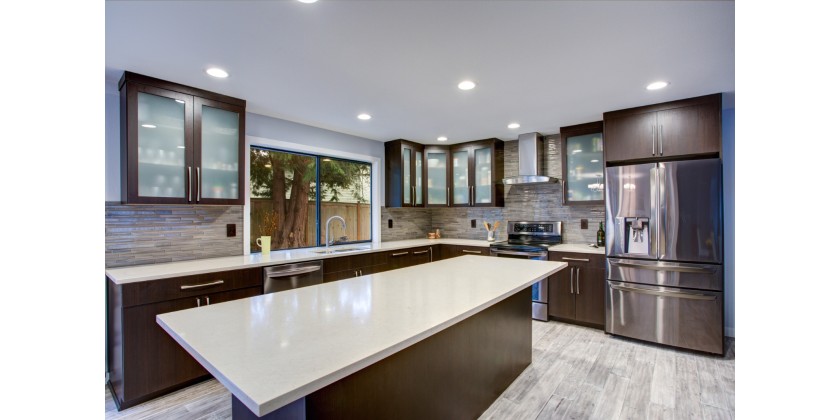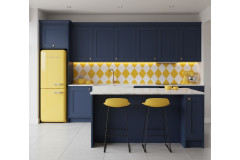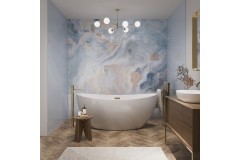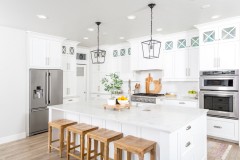
Back in the day, picking out new worktops for your kitchen basically boiled down to choosing the colour of the laminate.
However, we now have a dazzling array to choose from -- and the style stakes have risen as well.
Wooden and granite worktops may be fairly self-explanatory, but what is a solid surface countertop when it's at home?
Don't worry, we're here to explain all -- and it could be the perfect choice for your dream kitchen.
The Lowdown on Solid Surface Countertops
Defining a solid surface countertop should be pretty straightforward. After all, it should be a surface that's solid all the way through, right?
Turns out that right up to the present day, some manufacturers play fast and loose with the word 'solid'. Often what is sold as solid surface worktop is actually just a relatively thin layer of solid material, applied to an MDF subframe.
However, true solid surface countertops are just that -- solid all the way through.
While granite is a natural substance that looks great, it comes with all the natural flaws and cracks that are present in real stone products. Solid surface is a little different.
What Is Solid Surface Material?
Solid surface worktops give the appearance of natural stone, but actually are much more versatile and user-friendly.
They get their stone-like appearance from having stone dust mixed in. Primarily composed of acrylic or resin, they're blended with natural materials to produce the look, but not the properties of natural stone.
Some are made of polyester with stone mixed in. While cheaper, they're considered to be inferior in quality.
Because they're manufactured, they are highly customisable. This means that you can create bespoke kitchen designs that are sleek and seamless -- more on that later!
If you love flecks of bright, shiny stone or prefer a solid colour finish, you can have it. The possibilities are pretty much endless, as it can be made in a huge array of tones and styles.
What Makes Solid Surface Special?
As with most hybrid materials, the thinking behind it is to give the look of real stone, without its disadvantages.
While granite can look impressive, it's natural imperfections can quickly become a real headache -- and an expensive one at that.
The main problem with natural stone is that it is porous -- spills will soak in and stain it. As they contain natural faults they're also prone to cracking -- pretty much the end for your worktop.
The great thing about solid surface worktops is that the acrylic makes them totally non-porous, meaning spills can just be wiped off and forgotten. This means they're a hygienic option for your family.
They also take a lot of hammer.
Are the unscratchable? Well, no, not totally. That said, it's pretty tough to scratch them, and if you use a chopping board, this probably won't be an issue.
Hang on though -- here's the amazing part. If you do scratch them, they can be repaired.
By you. With a piece of sandpaper! Yep, it's as easy as that.
Even deeper scratches can be treated fairly easily with an orbital sander. No need to call out the 'solid surface repairman' -- just do it yourself.
What Are the Drawbacks?
Solid surface worktops are pretty great, but they do have a few limitations.
One slight con is that while they are pretty tolerant when it comes to heat, they're not totally heatproof. That means that you'll probably get away with a pan that's been on the boil, but not one that's been full of hot chip fat.
As has been mentioned, they also can be scratched. However, their non-porous quality and the ease with which scratches can be repaired makes this a minor consideration.
Stunning Design Possibilities
Now, this is where sold surface worktops get really exciting.
Solid surface worktops are incredibly customisable. One of the most popular and stylish options is to have an integrated sink, with draining board grooves cut into the solid surface.
This allows the tap to emerge gracefully from the worktop without being part of the sink unit itself. The rest of the sink sits below the surface, creating a sleek, visually stunning appearance.
The draining board makes the most of the non-porous nature of the material and again adds to the seamless appearance of the installation. This is high-end style for your home and is bound to add to its resale value.
Curves in All the Right Places
Because solid surface worktops are uniform all the way through, you can take advantage of this to create curved corners and seamless features.
Think kitchen islands with soft, curved corners and sink surrounds with rounded edges. All of this is eminently doable as solid surface is stable, won't crack like other stone surfaces and looks great all the way through.
Curves don't have to be limited to softened corners. If you'd like a curved breakfast bar or peninsula, then go ahead.
Really, when it comes to the shapes and styles that solid surface worktops can be crafted into, the only limits are your imagination and the space you're working with.
It gives you a great opportunity to create something totally unique -- totally bespoke -- in your kitchen. But the great thing is that solid surface won't break the bank. In fact, it's generally cheaper than natural stone.
Also, it doesn't require special tools and training to fit. Rather than having to bring in a specialist, your local kitchen fitter should be more than up to the task of installing it.
The Main Point: All You Need to Know About Solid Surface Countertops
If you're stuck between a rock and a hard place -- or maybe laminate and granite -- then solid surface countertops may be the answer to your dilemma!
Keep your kitchen safe and clean, get the sleek and stylish look you want and customise to your heart's content -- solid surface ticks all the boxes.
Click here to check out our great range of solid surface countertops today!












Leave a Reply Cancel Reply
All fields are required